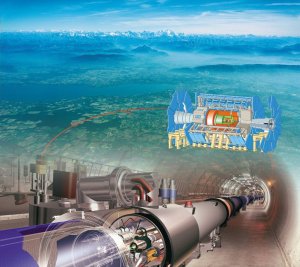Research in High-Energy Physics
Overview
 My research deals with the interactions of elementary particles, the basic components of all matter.
Many of these particles have not existed since the earliest seconds of the universe, but they can now be produced in collisions at very high energies.
Previous measurements of the particle interactions lead us to believe they may be more complex than our current beautiful theories predict.
My research deals with the interactions of elementary particles, the basic components of all matter.
Many of these particles have not existed since the earliest seconds of the universe, but they can now be produced in collisions at very high energies.
Previous measurements of the particle interactions lead us to believe they may be more complex than our current beautiful theories predict.
I work on experiments at high-energy hadron colliders to measure particle properties and search for new phenomena. The discovery of the Higgs boson opens new opportunities for us to probe the electroweak symmetry breaking sector (EWSB). This electroweak symmetry breaking seems to be the key for explaining how the fundamental particles acquire mass in gauge theories. Some theories predict new particles as a result of the symmetry breaking.
ATLAS experiment at the Large Hadron Collider (CERN)
The ATLAS experiment recorded data from proton-proton collisions at center-of-mass energies up to 8 TeV in 2009-2012 (Run 1), then 13 TeV in 2015-2018 (Run 2) and is now recording data at energies of 13.6 TeV (Run 3). The LHC energy and beam intensities are much greater than those at previous high-energy colliders, and we expect this will translate to increased production rates for exotic particles. Our group is involved with precision measurements of electroweak bosons and the Higgs boson as well as searches for supersymmetric particles and exotic resonances. We are especially interested in signatures of the Higgs boson decay to heavy quarks.
The greater energies and particle flux also present a challenge for the ATLAS detector design. The outer regions of the detector are 15 meters from the interaction point, in order to measure more accurately the charged particles' trajectories. The inner detectors — silicon detectors with precise tracking capabilities — have been designed to withstand very high radiation doses. Nevertheless, work has begun to design a replacement which will be even more radiation-hard. The SCIPP ATLAS group is involved in research and development for this project.